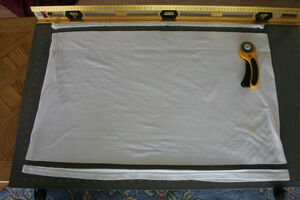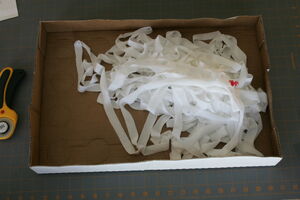Cotton t-shirt material makes a very nice tri-string material. Many t-shirts have no side seams. If you have a t-shirt with a hole in it, this is a very handy source for a great wick material.
Read this article to find out how to cut a long continuous strip from a t-shirt or a sock in just a few minutes.
There have been much discussion of t-shirt material on SBF, the Soap Bubble Fanciers Yahoo Group (RIP).
In this SBF thread, the advantages of different widths for the strips are mentioned.Dip Stix wands seem to use a t-shirt like material that is about 1/2" wide when uncurled. Some people have a preference for widths between 1" and 2".
Using T-Shirt Strips[]
Once you have cut the strips or loop (a t-shirt cross-section makes a nice unknotted continuous loop), you should pull to stretch it. This will encourage its natural tendency to roll up into a tubular shape.
It appears that lightweight 100% cotton is the best material. It is reported that any amount of polyester in the material detracts from its effectiveness as a bubble wick. Lightweight t-shirts seem to work better than heavier weight t-shirts.
The tubular nature of these strips may be advantageous for using it to wrap around other wick material if, for instance, you want a top-string that has more holding capacity than the side strings which seems like it would be advantageous for making giant bubbles although the author has not yet performed experiments to confirm this.
A large man's t-shirt can create strips 50 to 150 feet long after it has been stretched depending on how wide you cut the strips. An extra-large man's t-shirt cut into a strip 1" wide (2.5 cm) yields about 140 feet after gentle stretching. It is reported that a 3X Large man's t-shirt cut into a 19 mm wide strip (3/4") yields about 190 feet.
It has been reported that 1/2"-3/4" (19 mm) wide strips work better than wider strips -- on SBF a difference in performance between 3/4" and 1" was noted with the narrower strip performing better. Strips much narrower than 3/4" are reported to be problematic as they may be too weak to hold up well to stretching, and they may also become unusefully narrow as the material shrinks over repeated use.
Brian's Photo-Essay[]
Materials:
- unused lightweight t-shirt without side-seams (preferably the largest size 100% cotton undershirt that you can find
- rotary cutter
- cutting mat
- straight-edge
- (optional) scisoors
CLICK ON PHOTOS TO SEE AT LARGER SIZE

1. Lay out the t-shirt on the cutting mat.

2. Slice just below the arm and just above the hem. This will leave you with a seamless tube of jersey fabric.

3. Fold the t-shirt lengthwise (so that the tube is still open at the bottom and top) but leave a 'spine' at the side that is not doubled up. If your cutter is sharp (it probably is), fold again lengthwise leaving the 'spine' undoubled.

4. Slice horizontally the folded-over portion of the t-shirt creating strips. DO NOT slice on the 'spine' portion.

Step 4 zoomed-in

5. When you have cut all the strips, unfold the t-shirt. It should like this:

6. Open up the t-shirt so that the uncut "spine" is centered. If you are going to use the rotary cutter, put something (a book, the cutting mat, a piece of cardboard, etc) under the spine so that you do not cut through to the other side. You might want to use scissors for this part.

Cut diagonally as shown to create a continuous strip of 'yarn'.
7. Cut diagonally as indicated by the red lines. These cuts will create a single continuous strip.

7. The T-Shirt Yarn before stretching

8. The T-Shirt Yarn as it appears after stretching. Note how it has become narrower due to the curling that takes place when t-shirt yarn is stretched.

9. Wind the t-shirt yarn onto a spool for storage. The picture shows t-shirt yarn on a homemade spool cut from heavy cardboard.
Related[]
Put Yourself Through a Card[]
This YouTube video shows a technique (the same one highlighted in the article mentioned in the next paragraph) for cutting a card to create a large continuous loop that is related to the spiral cut technique.
This article at The Happy Scientist (with video) demonstrates a similar techique that can be used with a flat sheet of material. (NOTE Jan. 2016: the video is now behind a pay wall.) It is not certain that this would work well for creating a wick, but it would be interesting to try. Its theoretical advantage is that it creates a large continuous unknotted wick. However, ther are going to be sudden changes of grain that may (or may not) influence its effectiveness.